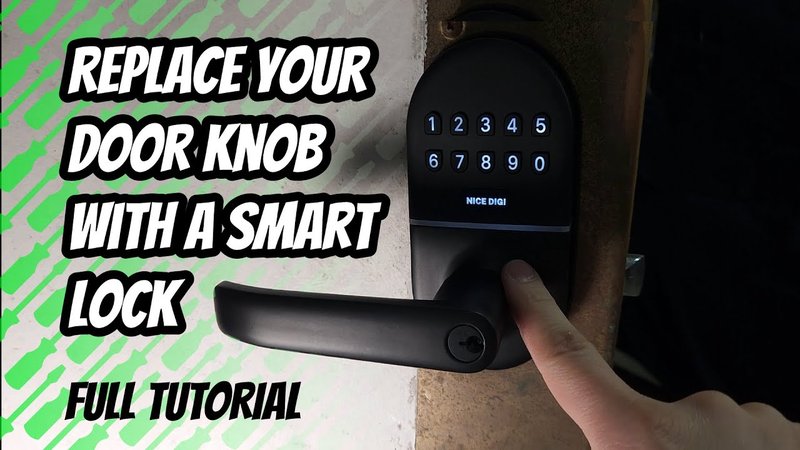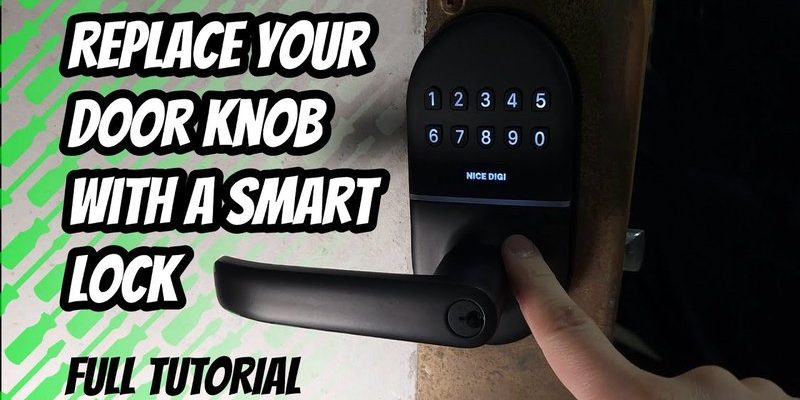
Honestly, recalibrating a smart lock after a door adjustment is a lot like resetting your phone after a big software update. Everything looks the same on the outside, but the invisible settings and alignment need a quick “Hey, start fresh.” Let me explain how you can get your lock working smoothly again—without frustration or a call to a locksmith.
What Happens When You Adjust Your Door?
Here’s the thing: a lot of people don’t realize how much a simple door tweak can throw off a smart lock. When you move strike plates, plane down a sticky edge, or even just tighten the hinges, you can change the way the deadbolt lines up with the hole in the frame. For most mechanical locks, you just wiggle the key a bit harder. But with a smart lock, precise alignment is everything.
Why? Smart locks use tiny sensors and gears to extend and retract the deadbolt to very specific points, based on what they “think” locked and unlocked should be. Even a few millimeters off can confuse the lock and cause problems like failed locking attempts, error codes, or a lock that keeps spinning without catching. If you’ve ever watched your August or Yale lock whirr and beep for no reason after a door adjustment, you know exactly what I mean.
Some homeowners get nervous—”Did I break my lock? Is something jammed?” Ninety percent of the time, the lock just needs to relearn its new start and stop points. That’s where recalibration—or sometimes a full factory reset—comes in. It’s not hard, but you need to follow the right steps for your brand and model.
When Should You Recalibrate Your Smart Lock?
You might be wondering: do you really need to recalibrate your smart lock every time you do something with the door? Not always, but here’s when you should stop and run a calibration:
- The lock seems harder to turn (manually or with the app) after an adjustment.
- Your app says the lock is “jammed” or you get error beeps and flashing lights.
- Auto-lock or auto-unlock features stop working smoothly, or you hear grinding noises.
- The bolt doesn’t fully retract or engage—your door won’t stay locked or won’t open.
If things feel “off,” trust your gut. Most brands—like Schlage, August, and Yale—have a recalibration or auto-align feature in their app or hardware. It’s always better to recalibrate than risk a security problem or a dead battery from a struggling motor.
Recalibrating can also help if you’ve replaced batteries, paired a new remote, or reset your lock’s code. These steps tend to make everything play nicer together, especially after any kind of “hardware shake-up.”
How Do Smart Locks Know Their Position?
Let me geek out for a second—because it helps to know what’s going on under the hood. Smart locks learn where “locked” and “unlocked” are using internal sensors, software, and sometimes even a built-in gyroscope. When you first install the lock, it usually asks you to open and close the door so it can map out its travel distance. This becomes the lock’s baseline.
After a door adjustment, though, those exact points change. If you moved the strike plate or changed weatherstripping, the “locked” position might now be a tiny bit farther away or closer than before. The lock will keep trying to hit its old marks. That’s like telling a robot to “walk ten steps forward” in a room you just rearranged—eventually it’s going to walk into a wall or miss the door entirely.
Recalibration lets the lock “forget” the old map and learn the new one. For some brands, like August or Yale, this can mean running a guided calibration in the app. Others, like Schlage, might use a quick button sequence to reset and recalibrate. Either way, you’re syncing the physical hardware with the digital brain.
Step-by-Step: How to Recalibrate a Smart Lock
Ready to get your lock synced up with your newly adjusted door? Here’s a general guide that covers most major brands. Always check your specific lock’s manual or support page for unique steps, but these should point you in the right direction:
- Open the smart lock app on your phone (like August, Yale Access, or Schlage Home).
- Look for a “calibrate,” “setup,” or “reset” option in settings or under device management.
- Follow the guided instructions—the app will usually ask you to open and close the door, then lock and unlock the bolt a few times.
- If your lock has a button for calibration, use it! Some models have a physical “reset” or “calibrate” button inside the battery compartment.
- Test the lock after calibration. Make sure it locks/unlocks smoothly with both the app and physically by hand.
Pro tip: If your lock offers a factory reset or pairing mode, only use that if recalibration doesn’t work—since it’ll wipe codes, remotes, and all your settings.
Some users get nervous about following on-screen prompts, but honestly, these apps are usually designed for absolute beginners. They often walk you through each step with big, clear buttons and tips. If you run into trouble, the most common issue is low batteries—change those first and try again.
Troubleshooting Common Smart Lock Issues After Door Adjustment
Even after you’ve recalibrated, sometimes things aren’t perfect. Here’s what to check if your smart lock still feels cranky:
- Deadbolt alignment: Open the door and extend/retract the bolt by hand. If it sticks or scrapes, tweak the strike plate or sand the frame just a hair more.
- Battery power: Low batteries make smart locks sluggish and can throw off calibrations. Replace with fresh, high-quality batteries if you see any weird behavior.
- App sync and code updates: Make sure your app and smart lock firmware are up to date. Some issues come down to buggy software, not physical misalignment.
- Remote or keypad pairing: If your lock uses remotes or a keypad, make sure those accessories are still paired and working after recalibration. Sometimes a reset can unpair them.
If all else fails, a full factory reset might be needed. This wipes all codes and settings, so you’ll need to re-pair remotes, reenter user codes, and let the lock learn everything from scratch. Not fun—but sometimes it’s the only way to clear stubborn sync issues after a big door adjustment.
Brand-Specific Tips: August, Schlage, and Yale Smart Locks
Each lock brand has its own quirks and recalibration process. Here’s a quick look at the three most popular ones you’ll find on front doors:
- August: Use the “Calibrate” option in the August app. It asks you to manually lock and unlock the door while the app listens for the lock’s motor and sets new positions. Quick and usually painless.
- Schlage Encode: You’ll need to hold the inside “reset” button until the light blinks, then follow the Schlage Home app to run calibration. This also resets any paired remotes or keypads, so keep those codes handy.
- Yale Assure: Go to “Settings” in the Yale Access app and select “Recalibrate.” If the lock still won’t behave, a full factory reset (using a pinhole button on the inside) may be needed.
Some lesser-known brands or universal smart locks might use a different process. If you’ve got a rare model, try searching the brand name plus “recalibrate after door adjustment”—that usually brings up a step-by-step from the manufacturer.
Do You Need to Reset, Recalibrate, or Pair?
You might hear people use “reset,” “recalibrate,” and “pair” like they’re all the same thing. They’re not. Here’s how they differ—and when to use each:
- Recalibrate: Realigns the lock’s sense of where “locked” and “unlocked” are. Use this after a door tweak or physical alignment change.
- Reset: Wipes all codes, users, and settings back to out-of-the-box state. Use this if troubleshooting fails or there’s a major glitch.
- Pair: Connects your lock to a remote, keypad, or your smartphone app. Do this after a reset, new battery, or when linking to new devices.
Sometimes, all you need is a quick recalibration. But if your lock’s acting like it completely lost its memory—or if you’re switching to a new phone or smart hub—you’ll want to reset or re-pair as well.
Smart home tech is supposed to make life easier, not harder. Separating these steps means you don’t waste time wiping your settings when all you really needed was a simple recalibration after a door adjustment.
Keeping Your Smart Lock Reliable Over Time
Once everything’s working, you’ll want your smart lock to stay reliable. Here are a few tips to keep things running smooth:
- Check alignment every few months—especially after storms or big temperature swings, since doors can swell or shrink.
- Replace batteries before they die, not after. Most apps give you a warning when power is low; don’t ignore it, or you’ll risk losing sync or code recognition.
- Update your app and firmware regularly. Brands like August, Schlage, and Yale roll out bug fixes that can improve sync, code security, and battery life.
- Keep an eye (and ear) out for new noises. Grinding or beeping means the lock is struggling—time to recalibrate.
If you ever need to readjust the door again, just plan on recalibrating right after. It’s one of those small chores (like resyncing your Wi-Fi) that makes everything work better and saves headaches down the road.
Final Thoughts: Making Smart Locks and Doors Work Together
So, if you’ve adjusted your door, changed how it closes, or just noticed your smart lock acting up, don’t panic. Recalibrating is your easiest first step to getting things working again. Whether you use an app-based lock like August or a keypad favorite like Schlage or Yale, all these brands make recalibration pretty beginner-friendly.
The main thing is this: smart locks and doors are a team. When the door changes, it’s only fair that the lock gets a chance to “learn” the new setup. With a little patience—and maybe a fresh set of batteries—you’ll have everything synced, secure, and running smoothly again in no time.
